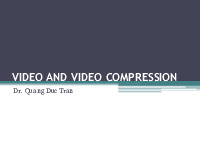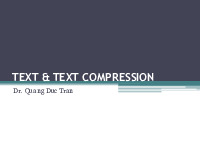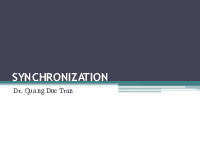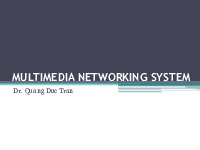



















Preview text:
IMAGE AND IMAGE COMPRESSION Dr. Quang Duc Tran Image
• All types of images are displayed in the form of a two-
dimensional matrix of individual picture elements (pixels). Pixel (RGB) Structure of Human Eye
6 million cones and 120 million rods Structure of Human Eye Color Models
• RGB (Red, Green, and Blue) – Computer Monitors.
RGBA is RGB with an additional channel, alpha, to indicate transparency.
• CMYK (Cyan, Magenta, Yellow, and Black) – Photo printing.
• YCbCr – Video capture system. YUV stores a luminance
value along with two chroma values.
• HSV – Artist. It is often more natural to think about
color in terms of hue and saturation than additive and subtractive color components Color Models (Cont.) HSV YCbCr (Y=0.5) RGB CMYK Color Models (Cont.)
• YCbCr is not an absolute color space, it is a way of encoding RGB information. YCbCr contains
perceptually meaningful information.
Y = 16+219(0.299R+0.587G+0.114B)/255
Cb = 128+224(-0.169R-0.331G+0.5B)/255
Cr = 128+224(0.5R-0.419G-0.081B)/255 Image Compression • Lossless Compression ▫ Run-Length coding (RLC) ▫ Huffman coding ▫ Lempel-Ziv coding • Lossy compression ▫ Transform coding ▫ Chroma sub-sampling ▫ JPEG Chroma Sub-sampling Chroma Sub-sampling (Cont.) • 4:4:4 (1:1) ▫ High end film scanners ▫ Cinematic postproduction. • 4:2:2 (3:2)
▫ High end digital video formats and interfaces • 4:1:1 (2:1) ▫ DVCPRO (e.g., NTSC, PAL ) • 4:2:0 (2:1) ▫ MPEG, H.26X video coding ▫ DVD, Blue-ray Disc ▫ JPEG, MJPEG JPEG Standard Dr. Quang Duc Tran JPEG Standard
• JPEG is an image compression standard that was
developed by the “Joint Photographic Experts Group”.
• JPEG is the most common format for storing and
transmitting photographic images.
• JPEG works with both color and grayscale images
• The compression rate is typically 10:1 with little
perceptible loss in image quality JPEG Standard (Cont.)
• JPEG is a lossy compression technique. It employs 2D-
DCT (Discrete Cosine Transform) transform coding,
whose effectiveness replies on 3 major observations:
▫ Observation 1: Useful image contents change relatively slowly across the image.
▫ Observation 2: Humans are much less likely to notice the
loss of very high spatial frequency components than the loss of low frequency components.
▫ Observation 3: Visual acuity (accuracy in distinguishing
closely spaced lines) is much greater for gray than for color. JPEG Coding 88 blocks Entropy Compressed Image FDCT Quantization Encoding Source Image Quant. Table Huffman Table 88 blocks Entropy IDCT Dequantization Decoding Source Image Quant. Table Huffman Table Energy Compaction
• Energy Compaction means that a large proportion of the
total signal energy is contained in a handful of high-
valued coefficients. The larger coefficients are likely to
have higher psychovisual significance than their low-
valued counterparts and can be coded accordingly.
• Energy compaction is important for image compression.
In many practical situations, the image tend to have
most of their energy in the lower frequencies. Fourier Transform
• The Fourier transform is not actually optimal for image
coding since the DCT can give a higher compression rate, for the same image quality. DCT components are much more concentrated than those for the Fourier. DCT has been considered as optimal for image coding. (a) FFT (b) DCT Principal Component Analysis
• PCA is a statistical method that uses orthogonal
transformation to turn a correlated set of data into a linearly
uncorrelated set of data, which contain principal components.
• PCA can be used to compress an image, it represents spatial
information in an image in a more compact “energy-like” representation.
• PCA is more efficient than the DCT, but it is far more computationally expensive. Discrete Cosine Transform
• DCT transforms a signal of image from the spatial domain to the frequency domain.
• DCT is similar to the Fast Fourier Transform (FFT) but can
approximate lines well with fewer coefficients.
• For most images, much of the signal energy lies at low
frequencies, which appear in the upper left corner of the DCT
• Compression is achieved since the lower right values
represent higher frequencies and are often small – small
enough to be neglected with little visible distortion. Discrete Cosine Transform C M-1N-1 æp ö æp ö F (2k +1)u (2l +1)v
(u, v) = 4Ck l
f (x, y)cos åå ç ÷cosç ÷ MN è 2M ø è 2N ø k=0 l=0 ìï ìï C = 1/ 2 If k = 0 í C = 1/ 2 If k = 0 í k l îï 1 Otherwise îï 1 Otherwise




